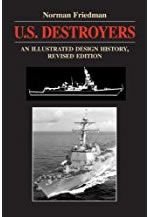|
|
USS Ordronaux (DD-617) was a Benson class destroyer that supported the invasion of Sicily, helped sink U-856, supported the fighting around Anzio and the invasion of the south of France, before moving to the Pacific where she supported a bombardment of Wake Island.
The Ordronaux was named after John Ordronaux, a French privateer who worked for the United States during the War of 1812.
The Ordrnonaux was laid down by the Bethlehem Steel Co at Fore River, Mass on 25 July 1942, launched on 9 November 1942 when she was sponsored by Mrs J. Henry Judik and commissioned on 13 February 1943.
1943
The Ordronaux’s left New York on 1 May 1943 to escort a convoy to Mers-el-Kebir in Algeria. She was then allocated to the forces being gathered for the invasion of Sicily and moved to Bizerte. On 6 July she had her first combat, when the naval base was attacked by German aircraft.
On the day of the invasion of Sicily, 9 July, the Ordronaux escorted a squadron of torpedo boats. Their combined role was to block the harbour at Port Empedocle and destroy any German E-Boats or Italian MAS boats that came out to sea. The Ordronaux remained off Sicily until 21 July, forming part of the anti-submarine screen and providing fire support for the fighting onland.
For most of the next year she served on convoy escort duties, largely on the routes from the US to the Mediterranean.
1944
At the start of April 1944 the Ordronaux was part of a hunter-killer task unit built around the escort carrier USS Croatan (CVE-25) and a group of destroyers and destroyer-escorts. On 7 April carrier aircraft and the Ordronaux detected U-856 on the surface while operating to the south of Nova Scotia. Champlin (DD-601) made the first sonar contact, and she and the Huse (DE-145) then made several depth charge attacks. The submarine was forced to the surface, and the two ships opened fire. The Champlin then rammed the U-boat (during this part of the battle her captain was fatally wounded). The U-boat sank, and the Nields (DD-616) and Ordronaux rescued 28 survivors.
In May the Ordronaux joined the forces supporting the fighting in Italy. On 12 May she and the MacKenzie (DD-614) screened the British cruiser HMS Dido while she bombarded Terracina and Gaeta on the west coast of Italy to support the US 5th Army’s advance on Rome. She spent the rest of May supporting Dido and the French cruiser Emile Bertin as they supported the fighting at Anzio.
During the invasion of the South of France (Operation Dragoon) she was part of Rear Admiral Morton L. Deyo’s Bombardment Group, built around the Arkansas (BB-33), one America, one British and two French cruisers. On 9 August she was allocated to a fire support force and on the first day of the invasion, 15 August, she operated within 3,000 yards of her beach, providing on call fire support in response to Navy liaison officers and Army spotters. During the day she repeatedly came under fire from shore batteries.
After the naval part of the invasion was over she returned to convoy escort duties.
On 30 October-3 November she escorted the Savannah as she carried out standardization trials off Rockland, Maine and the Delaware Capes.
1945
With the war in Europe coming towards its end, on 1 May 1945 the Ordronaux arrived at New York for alterations to prepare for a move to the Pacific. She reached Pearl Harbor on 24 July, and unlike many destroyers that switched theatre at this late date arrived in time to take part in combat operations.
On 1 August she took part in a naval bombardment of Wake Island, carrying out close fire support and once again being the target of shore guns. She also rescued Lt Gordon F. Gossman, one of the Curtiss SC-1 Seahawk pilots from the Pennsylvania which had lost a float and capsized during an attempt to bring the aircraft back onto the battleship.
She reached Okinawa several days before the Japanese surrender. She then took part in the occupations of Wakayama and Nagoya in the Japanese Home Islands and visited several ports in Honshu, including two trips to Tokyo Bay. She departed for the United States on 31 October.
After her return to the US she carried out local operations of Charleston, before being decommissioned in January 1947. She was struck off on 1 July 1971 and sold for scrap in 1973.
Ordronaux earned three battle stars for service in World War II, for Sicily, Anzio and the South of France.
Displacement (standard) |
1,620 design |
Displacement (loaded) |
2,474t |
Top Speed |
37.89kt at 51,390shp at 2,065t on trial (Mayo) |
Engine |
2-shaft Westinghouse turbines |
Range |
6,500nm at 12kt design |
Armour - belt |
|
- deck |
|
Length |
348ft 1in |
Width |
36ft 2in |
Armaments |
Five 5in/38 guns |
Crew complement |
191 |
Laid Down |
25 July 1942 |
Launched |
9 November 1942 |
Commissioned |
13 February 1943 |
Struck off |
1 July 1971 |
Sold for scrap |
1973 |
 U.S. Destroyers: An Illustrated Design History, Norman Friedmann .
The standard history of the development of American destroyers, from the earliest torpedo boat destroyers to the post-war fleet, and covering the massive classes of destroyers built for both World Wars. Gives the reader a good understanding of the debates that surrounded each class of destroyer and led to their individual features.
U.S. Destroyers: An Illustrated Design History, Norman Friedmann .
The standard history of the development of American destroyers, from the earliest torpedo boat destroyers to the post-war fleet, and covering the massive classes of destroyers built for both World Wars. Gives the reader a good understanding of the debates that surrounded each class of destroyer and led to their individual features.